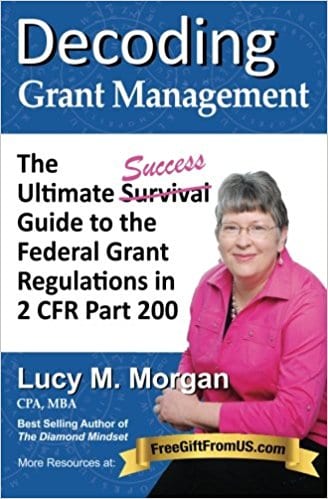Table of Contents
Risk Assessment in the new federal grant-writing environment
By Lucy Morgan
 When you say the word “risk” different things come to mind. One of the riskiest things I can imagine would be running with the bulls in Pamplona Spain. This annual event pits a group of racers against a herd of crazed bulls and was originally designed to move the bulls quickly through the town using a mixture of fear and excitement for both the bulls and the participants.
When you say the word “risk” different things come to mind. One of the riskiest things I can imagine would be running with the bulls in Pamplona Spain. This annual event pits a group of racers against a herd of crazed bulls and was originally designed to move the bulls quickly through the town using a mixture of fear and excitement for both the bulls and the participants.
For funding agencies, one of the riskiest things they can than think of is when the sponsored program is not completed, or falls woefully short of the objectives. Even worse is the very real risk of program waste, fraud and abuse occurring with taxpayer funds. This nightmare brings tons of bad press, public outcry and congressional investigations.
The New Age of Accountability and Performance
 Now fast forward to the big changes happening in the world of federal grants with the advent of the new Uniform Guidance contained in 2 CFR Part 200. One of the many changes brought about by this offshoot of the risky spending days of the Stimulus grants, (aka the American Recovery and Reinvestment Act or ARRA) was the desire to shift risk from the federal government and make individual grant recipients such as school districts, local governments and institutions of higher education more accountable. In other words, the federal government seeks to clear the field of any grant recipients who can’t keep up with the new accountability and performance expectations by pulling them from the race before they even get started.
Now fast forward to the big changes happening in the world of federal grants with the advent of the new Uniform Guidance contained in 2 CFR Part 200. One of the many changes brought about by this offshoot of the risky spending days of the Stimulus grants, (aka the American Recovery and Reinvestment Act or ARRA) was the desire to shift risk from the federal government and make individual grant recipients such as school districts, local governments and institutions of higher education more accountable. In other words, the federal government seeks to clear the field of any grant recipients who can’t keep up with the new accountability and performance expectations by pulling them from the race before they even get started.
Let’s look at how the federal government plans to accomplish this:
Step One: Are You Ready for the Race?
 Being “grant-ready” is more important for federal grants than ever before. That is because the new grant regulations require funding agencies to complete a risk and integrity assessment before awarding federal funds. Wondering what that looks like? While the new regulations stop short of laying out a checklist for potential grant recipients, the guidance gives you a framework for the risk and integrity assessment with several focus areas. Here are some of the main considerations:
Being “grant-ready” is more important for federal grants than ever before. That is because the new grant regulations require funding agencies to complete a risk and integrity assessment before awarding federal funds. Wondering what that looks like? While the new regulations stop short of laying out a checklist for potential grant recipients, the guidance gives you a framework for the risk and integrity assessment with several focus areas. Here are some of the main considerations:
- Ability to meet management standards
- Amount of monitoring already in place with other federal agencies or prime recipients
- Evaluation of the application for funding opportunity
- Extent of new personnel or changed systems
- Past history of performance for federal awards and sub-awards
- Previously submitting applicable reports in a timely manner
- Prior compliance with award terms and conditions
- Quality of the management systems
- Results of audits such as findings and questioned costs
- Stability of finances at the organization
 Smart grant writers and administrators will start addressing the areas of risk and integrity as they contemplate applying for federal awards. As the grant narrative is developed, organizations should explicitly address these areas that make up the risk framework.
Smart grant writers and administrators will start addressing the areas of risk and integrity as they contemplate applying for federal awards. As the grant narrative is developed, organizations should explicitly address these areas that make up the risk framework.
See more at § 200.205 Federal awarding agency review of risk posed by applicants.
Step Two: Do You Know the Risks of Applying Too Soon?
In the past many organizations applied for grants with the attitude of “If we get the grant, we’ll put good controls in place then.” However, applying for federal funds without being “grant-ready” is riskier than ever thanks to an addition to the new grant regulations that took effect at the beginning of 2016.
 Effective January 1, 2016, the new risk assessment requires federal agencies to report applicants who are deemed “not-qualified” for a federal award to the Federal Awardee Performance and Integrity Information System (FAPIIS). Once an organization is on the federal “naughty” list, that status is retained in FAPIIS for a period of five years. In addition, the updated regulations require funding agencies to review FAPIIS as part of a risk assessment prior to awarding grants greater than $150,000 and must consider the “non-qualified” applicant status in making decisions about future awards.
Effective January 1, 2016, the new risk assessment requires federal agencies to report applicants who are deemed “not-qualified” for a federal award to the Federal Awardee Performance and Integrity Information System (FAPIIS). Once an organization is on the federal “naughty” list, that status is retained in FAPIIS for a period of five years. In addition, the updated regulations require funding agencies to review FAPIIS as part of a risk assessment prior to awarding grants greater than $150,000 and must consider the “non-qualified” applicant status in making decisions about future awards.
Step Three: Do You Accept Responsibility for the Risks?
Finally, each grant recipient needs to realize that there is a whole new level of “gotchas” baked into the new grant regulations in the form of mandatory disclosures and certifications. Have a problem down the road with your grant? Expect the responsibility to fall solidly back in the lap of the grant recipient and not the federal agency.

The main way the advantage in finger pointing will go to the funding agency is a little thing called the new “Certification of Costs” requirement. The new regulations require a senior official of the non-federal entity to expressly acknowledge that making bogus statements about program spending can lead to prosecution under the False Claims Act. Here’s what an official who can legally bind your organization will need to certify:
‘‘By signing this report, I certify to the best of my knowledge and belief that the report is true, complete, and accurate, and the expenditures, disbursements and cash receipts are for the purposes and objectives set forth in the terms and conditions of the Federal award. I am aware that any false, fictitious, or fraudulent information, or the omission of any material fact, may subject me to criminal, civil or administrative penalties for fraud, false statements, false claims or otherwise.”
 The statement must be included in the annual and final fiscal reports or vouchers requesting payment under the federal agreements. Don’t be lulled to a false feeling that nothing changed from the previous version of the grant regulations. The regulations were beefed up to require an “official who is authorized to legally bind the non-Federal entity” rather than the old vague requirement of a “responsible” official. The crime of omission was also added to the new language, where if you know something significant has gone haywire and you don’t come forward and tell your funding agency, you could be prosecuted. So now it’s even more important that federal funds flow to the purpose for which they are intended and grant recipients actively work to reduce the risk of mismanagement of grants.
The statement must be included in the annual and final fiscal reports or vouchers requesting payment under the federal agreements. Don’t be lulled to a false feeling that nothing changed from the previous version of the grant regulations. The regulations were beefed up to require an “official who is authorized to legally bind the non-Federal entity” rather than the old vague requirement of a “responsible” official. The crime of omission was also added to the new language, where if you know something significant has gone haywire and you don’t come forward and tell your funding agency, you could be prosecuted. So now it’s even more important that federal funds flow to the purpose for which they are intended and grant recipients actively work to reduce the risk of mismanagement of grants.
Winning the Race Against Risk
Grants from the federal governments pump over $600 billion dollars of funding into worthy causes every year in the United States. If you are moving through the grant process with a mixture of fear and excitement, you are not alone. Get ready to run the race by preparing for the new requirements during the grant application process. Make sure you understand what “strings” are attached to those federal dollars before you start spending. And finally make sure leadership at your organization is onboard with the new integrity and accountability certifications and disclosures.
Ms. Morgan’s book is available on Amazon.com

Author
- Black Enterprise – Trump Overturns Education Regulations
- NPR – Education Budget Cuts, Student Aid Problems And More
- EdSource – Charter schools in line to get extra help despite Trump plan to slash education funding


